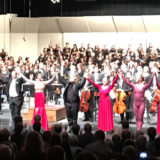By Tim Gaylard Special to The Roanoke Times
The Roanoke Symphony Orchestra continued its Masterworks Series on Saturday night under the baton of David Stewart Wiley at the Berglund Performing Arts Theatre before a crowd of 1,200. Joining the orchestra for three of the pieces were the Roanoke Symphony Chorus and the Liberty University Concert Choir, both led by John Hugo.
The concert began quite late because of an unbelievable traffic jam of cars arriving at the same time for both this concert and a hockey game next door. Planners for such events should consider the limitations of parking in the area, and the great inconvenience this creates for the spectators and audience members.
The first piece on the program was Glazunov’s very appealing March on a Russian Theme. Wiley allowed the main melody to unfold as a noble line, grandly, like a procession. In the middle, the well-blended winds were featured, and then the last section brought back the grandeur of the beginning, amplified by the brilliant brass and glittering percussion.
The maestro briefly spoke to the audience, summarizing the highlights of the evening’s program and informing us that the Glazunov and the Rimsky-Korsakov pieces were being played for the first time by the symphony.
Borodin’s familiar In The Steppes of Central Asia was executed with great care, from the opening haunting tones of Carmen Eby’s clarinet to the evocative sound of Jessica Warner’s English horn. Atmospheric timbres abounded, from the violin harmonics to the delicate cello pizzicati. After generously lyrical outpourings from the strings, the music faded to a beautiful and breathtaking close.
Wiley next conducted a cohesive and coherent interpretation of Tchaikovsky’s beloved Romeo & Juliet Fantasy Overture. Here the slow introduction flowed easily and did not drag, always maintaining a sense of momentum. The dramatic rendering continued with an exciting fast section. The strings played with precision in their rushing passages, as the brass and percussion provided their jolting syncopations. The range of dynamics was well-controlled, surging forward to climaxes and dying away to carefully calibrated echo effects.
The familiar love theme was restless, not turgid or self-indulgent, as is often the way this melody is interpreted. Instead, Wiley kept the tension going tautly all the way to the shattering final funeral march; he created an overall shape to the piece that was truly effective, and very worthy of the Shakespearean tragedy that inspired it.
After the intermission, the choruses assembled on the stage, and John Hugo was suitably honored for his 20-year association with the RSO. Then Wiley launched into a rhythmically charged rendition of Borodin’s Polovetsian Dances from Prince Igor.
The choruses here were noticeably amplified but still provided expressive and well-intoned melodies. There were a few lapses in ensemble, but generally the performance was exciting. The orchestra dutifully gave strong support, especially the busy percussion section, which remained reliably accurate.
Hugo then conducted Rimsky-Korsakov’s grandiose arrangement of Slava, the very familiar — and intensely nationalistic — Russian tune. There were nice stretches of full-throated choral sound, and Hugo’s beat was tight and propulsive, yet still allowed the singers to breathe and the orchestra to swell to a roof-shaking conclusion.
Wiley came back one more time to conduct a severely abridged version of Tchaikovsky’s enduring 1812 Overture. The opening section, with divided low strings, sounded a little rushed; because there were no Russian peasant melodies, the music moved too quickly into the bombastic finale with the chorus intoning the Hymn to the Tsar. Still, the audience gave the performance an enthusiastic standing ovation; Wiley responded by having all the forces on the stage give an encore — a reprise of the very last dance from the Prince Igor set.
Timothy Gaylard is professor of music at Washington and Lee University.

